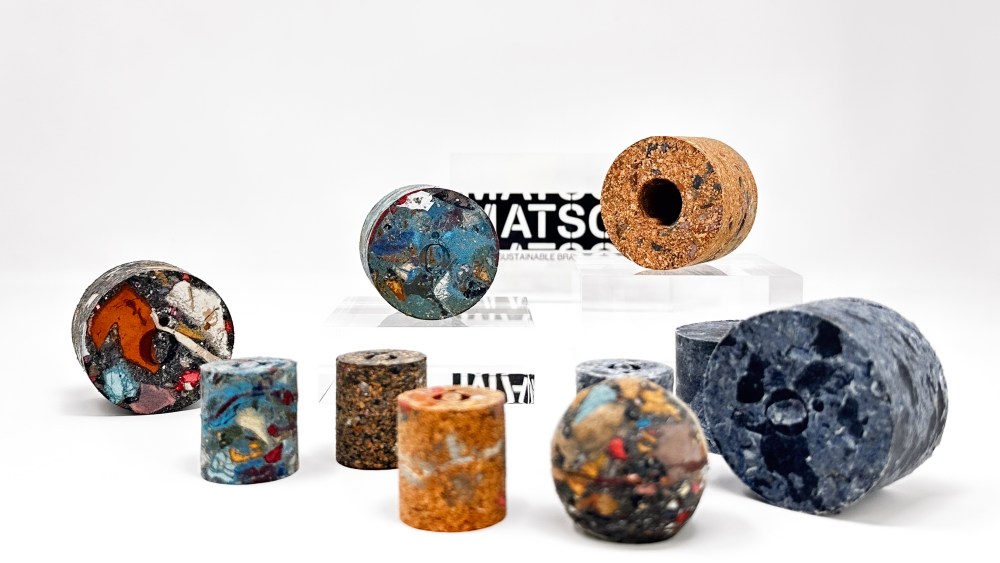PARIS — Green is the new black for beauty packaging suppliers.
In short, sustainability is no longer just a buzzword, with companies rapidly changing their practices to meet green goals set by government authorities. On the continent, for example, the European Union aims to achieve a circular economy by 2050. And decades before that, by 2030, the EU wants to make all plastic packaging cost-effectively reusable or recycled.
Packaging suppliers are therefore quickly strengthening their capabilities, as evidenced by the latest Luxe Pack trade fair held in Monaco from September 30th to October 2nd.
There was a paper trail going on. Italian luxury paper manufacturer Favini showcased a new addition to its Refit line: paper made from upcycled denim.
“This is post-consumer waste, especially jeans,” said Paola Melega, marketing assistant at Favini. She explained that the company used only wool or cotton in its Refit product line.
refit denim
This product contains 50% recycled content, half of which is denim. It is also FSC and Global Recycling Standard certified and produced using hydroelectric energy.
In the beauty industry, refit denim is sometimes used for product packaging, catalogues, etc.
Spain’s Pujorasos has unveiled its new sustainable brand, “Masos”. Waste products from materials such as denim, leather and cork are processed and, in some cases, mixed together to create eye-catching mottled caps used in beauty products.
“It’s upcycling,” says Pujorasos marketing manager Montse Font. “This is a new way to create better solutions for the industry. There’s a lot of waste in the fashion industry.”
Another paper alternative, this time for plastic bags, has been developed by Gardner, Massachusetts-based Seaman Paper.
“We produce our own tissue paper in the United States and Asia and sell it around the world,” said Natalie Palantoen, head of European sales. That way, she explained, they can keep their carbon footprint as low as possible.
Seaman Paper developed the Vela series as an alternative to single-use plastic bags.
“All of our products are 100% paper,” she added, and are fully recyclable. “The transparency of our paper is very innovative because it replaces clear plastic.”
The new version, developed using pure pulp, is strong, durable and customizable. This bag might be useful, for example, to hold cosmetics and beauty accessories hung on pegs in a store.
“It’s now very commonly used in the apparel industry and in shipping packaging,” Parantoen said.
The material chosen for the packaging of Concept4’s lip balm tubes was paper. This included a manual push-up mechanism that replaced traditional plastic rotating components.
Vela bag courtesy of Seaman Paper
“That’s what sets us apart,” says Kate Harrison, director of new product development and marketing at the Hong Kong-based full-service company. This makes the lip balm packaging completely recyclable.
Concept4 also showcased digital tools that help estimate the carbon footprint of products.
“This is a great tool when doing product development,” says Harrison. The entire process is considered, including the type of energy used and waste management.
“This is a tool to work with factories to set KPIs to improve their carbon footprint,” Harrison says.
In order to be as environmentally friendly as possible, Scentys, the French manufacturer of fragrance diffusion technology, has introduced a new invention at Luxe Pack: sustainable and reusable capsules made from a mixture of metal and plastic. These work with recyclable polymer refills.
“Brands want to use less plastic,” said Aurian Herrmann, key account manager at Sentis. The patented fragrance technology manufacturer also showed how the system can be used as a car diffuser.
Scenties sustainable capsule. Provided by Sentis
France’s Lessonia was selling biodegradable and compostable cosmetic masks in recyclable bags.
“The sachets are OPP (or polypropylene) oriented, so no aluminum foil is used,” says area sales manager Nina Roussel.
She explained that the mask itself is made from various eco-materials such as lyocell, wood cellulose, and biocellulose, as well as fermented coconut water. Some are made of cotton, linen, and charcoal.
“Then choose a serum,” she said.
The company highlighted a new magic sheet mask with a design made of Lyocell and made with thermochrome ink. When you mix it with a serum and apply it, the heat from your skin will cause the graphic to disappear.
“There are many possible formats: the face, neck, under the eyes, lips, pregnant belly,” says Roussel.
These innovative products were among the nominees for the Luxe Pack in Green Awards, which recognize environmentally friendly packaging innovation and CSR initiatives.
Monaco’s trade fair was held at the Grimaldi Forum, but next year it will be extended from September 29th to October 1st.
Nathalie Grosdidier, Deputy General Director of Infopro Digital, organizer of the Luxe Pack, said: Its space is 15% to 20% larger, which equates to an increase of 64,585 square feet.
He said that although the trade fair is evolving, it is always built on a DNA of carefully selected, innovative and international elements.
As an example of innovation, Grodidier said: “We are creating a new section that will be the gateway to tomorrow’s evolving packaging ecosystem. That means new actors, materials, technologies and services.”
Artificial intelligence, printed electronics, 3D printing, and more are all possibilities.
From Concept4 Provided by: Concept4
“We will also develop a more international conference program, drawing on the experience of many brands around the world,” she added. The idea is to bring together industry consortiums from all over the world so they can brainstorm, or share and exchange ideas.
For networking, there will be more terraces indoors and outdoors where people can gather and animations may take place in the expanded building.
The Luxe Home section, which focuses on home fragrances, will also be expanded. “We are doubling the number of exhibitors in this sector,” said Luxe Pack director Fabienne Germont.
However, exhibitions will continue to be selective. “It’s in our DNA,” Grodidier said.

